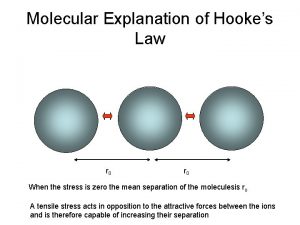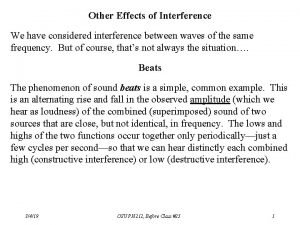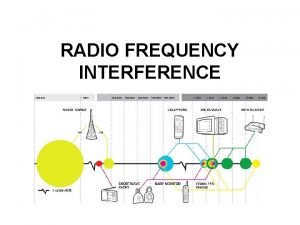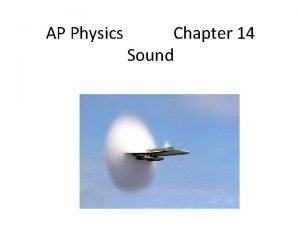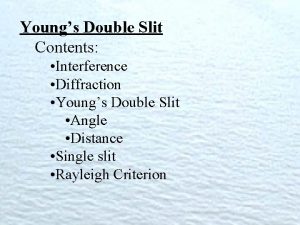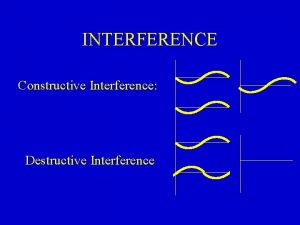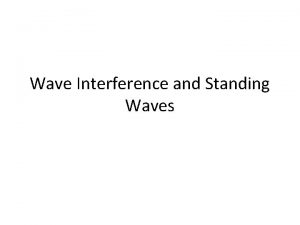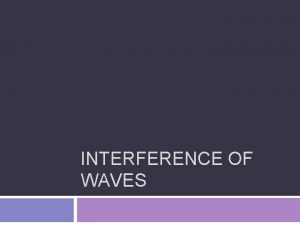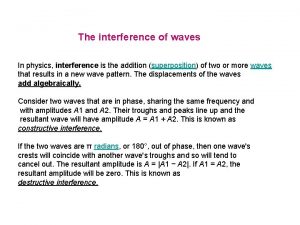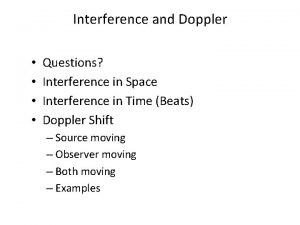Physics 6 C Interference of EM Waves Youngs




















- Slides: 20

Physics 6 C Interference of EM Waves

Young’s Double Slit Experiment y In Young’s double-slit experiment light comes from the left and passes through the slits, illuminating the screen some distance L away. The light rays from the 2 slits will travel different distances to get to the screen (except in the center). Depending on the path length difference the waves will be in phase or out of phase when they arrive at the screen. If they are in phase, they combine to give constructive interference (a bright region). Out of phase means destructive interference (dark region). Some geometry gives us a formula for this difference in path length: dsin(θ). This yields the following formulas: m can be any integer (m=0, ± 1, ± 2, ± 3, ± 4, …) y = actual distance on screen (from center)

Here’s a sample problem: Light with wavelength 546 nm passes through two slits and forms an interference pattern on a screen 8. 75 m away. If the linear distance on the screen from the central fringe to the first bright fringe above it is 5. 16 cm, what is the separation of the slits?

Here’s a sample problem: Light with wavelength 546 nm passes through two slits and forms an interference pattern on a screen 8. 75 m away. If the linear distance on the screen from the central fringe to the first bright fringe above it is 5. 16 cm, what is the separation of the slits? This should be a straightforward problem. We are given enough information to just use our formulas. Start with the formula involving the distance on the screen:

Here’s a sample problem: Light with wavelength 546 nm passes through two slits and forms an interference pattern on a screen 8. 75 m away. If the linear distance on the screen from the central fringe to the first bright fringe above it is 5. 16 cm, what is the separation of the slits? This should be a straightforward problem. We are given enough information to just use our formulas. Start with the formula involving the distance on the screen:

Here’s a sample problem: Light with wavelength 546 nm passes through two slits and forms an interference pattern on a screen 8. 75 m away. If the linear distance on the screen from the central fringe to the first bright fringe above it is 5. 16 cm, what is the separation of the slits? This should be a straightforward problem. We are given enough information to just use our formulas. Start with the formula involving the distance on the screen: Use this angle in the formula for bright fringes, with m=1

Here’s a sample problem: Light with wavelength 546 nm passes through two slits and forms an interference pattern on a screen 8. 75 m away. If the linear distance on the screen from the central fringe to the first bright fringe above it is 5. 16 cm, what is the separation of the slits? This should be a straightforward problem. We are given enough information to just use our formulas. Start with the formula involving the distance on the screen: Use this angle in the formula for bright fringes, with m=1

Multiple Slits (diffraction gratings) These work just like the double slit experiment (same formula), but the bright spots are narrower, and the dark spots are wider. If the grating has more slits the result is a sharper image, with narrower bright fringes.

Single Slit Diffraction Very similar to the double-slit experiment. The formulas are opposite (the math just comes out that way). Notice that the central maximum is double-width compared to the others. This is how you can tell a single-slit pattern from a multiple-slit pattern.

Here’s a sample problem: How many dark fringes will be produced on either side of the central maximum if green light (λ=553 nm) is incident on a slit that is 8µm wide?

Here’s a sample problem: How many dark fringes will be produced on either side of the central maximum if green light (λ=553 nm) is incident on a slit that is 8µm wide? This is a single-slit problem, so the formula for the dark fringes is:

Here’s a sample problem: How many dark fringes will be produced on either side of the central maximum if green light (λ=553 nm) is incident on a slit that is 8µm wide? This is a single-slit problem, so the formula for the dark fringes is: Let’s find the angles to the first few dark fringes. We get a new angle for each value of m. m θ 1 4° 2 8° 3 12° 4 16° 5 20°

Here’s a sample problem: How many dark fringes will be produced on either side of the central maximum if green light (λ=553 nm) is incident on a slit that is 8µm wide? This is a single-slit problem, so the formula for the dark fringes is: Let’s find the angles to the first few dark fringes. We get a new angle for each value of m. m θ 1 4° 2 8° 3 12° 4 16° 5 20° So far our answer is “at least 5” – but how will we know when we have found the last fringe?

Here’s a sample problem: How many dark fringes will be produced on either side of the central maximum if green light (λ=553 nm) is incident on a slit that is 8µm wide? This is a single-slit problem, so the formula for the dark fringes is: Let’s find the angles to the first few dark fringes. We get a new angle for each value of m. So far our answer is “at least 5” – but how will we know when we have found the last fringe? m θ 1 4° 2 8° Recall the diagram for single-slit diffraction. 3 12° 4 16° For the fringes to show up on the screen, the angle must be less than 90°. 5 20° Of course the pattern gets very dim near the edges, but mathematically the formula will break down when sin(θ)>1.

Here’s a sample problem: How many dark fringes will be produced on either side of the central maximum if green light (λ=553 nm) is incident on a slit that is 8µm wide? This is a single-slit problem, so the formula for the dark fringes is: Let’s find the angles to the first few dark fringes. We get a new angle for each value of m. So far our answer is “at least 5” – but how will we know when we have found the last fringe? m θ 1 4° 2 8° We are looking for the value of m that will give an angle greater than 90°. 3 12° Or equivalently, when sin(θ)>1. 4 16° 5 20° So we will get 14 dark fringes – the 15 th would be beyond the 90° angle, so it would not appear on the screen

Thin Film Interference Basic idea is that we will compare the two reflections. If they are in phase we have constructive interference (bright). If they are out of phase we have destructive interference (dark). Important details: 1) When light reflects from a higher-index medium it is phase-shifted by ½ of a wavelength. If both reflected rays have this shift we can ignore it, but if only one of them is shifted, we have to switch the formulas for constructive/destructive interference. 2) The wavelength in the formulas is the wavelength in the film, so we have to divide the vacuum wavelength by the index of the film. http: //mysite. verizon. net/vzeoacw 1/thinfilm. html

Here’s a sample problem: a) What is the minimum soap-film thickness (n=1. 33) in air that will produce constructive interference in reflection for red (λ=652 nm) light? b) Which visible wavelengths will destructively interfere when reflected from this film?

Here’s a sample problem: A thin layer of magnesium fluoride (n=1. 38) is used to coat a flint-glass lens (n=1. 61). a) What thickness should the Mg. F 2 coating be to suppress the reflection of 595 nm light? b) To suppress the reflection of light with a higher frequency, should the coating be thinner or thicker?

Here’s a sample problem: A thin film of oil (n=1. 40) floats on water (n=1. 33). When sunlight is incident vertically, the only colors that are absent from the reflected light are blue (458 nm) and red (687 nm). Estimate thickness of the film.

Link to a butterfly wing animation http: //graphics. ucsd. edu/~iman/Morpho/
 Retroactive vs reactive
Retroactive vs reactive Retroactive interference
Retroactive interference Young's modulus units
Young's modulus units Eleanor van tassel brush
Eleanor van tassel brush Young’s creative process
Young’s creative process Wave interference
Wave interference Draw the interference pattern for the two waves
Draw the interference pattern for the two waves Rf interference
Rf interference Interference of sound waves
Interference of sound waves Constructive interference of standing waves
Constructive interference of standing waves Interference of light engineering physics
Interference of light engineering physics Electromagnetic waves vs mechanical waves
Electromagnetic waves vs mechanical waves Compare and contrast p waves and s waves using venn diagram
Compare and contrast p waves and s waves using venn diagram Mechanical waves characteristics
Mechanical waves characteristics Sound waves longitudinal waves
Sound waves longitudinal waves Mechanical and electromagnetic waves similarities
Mechanical and electromagnetic waves similarities Mechanical waves and electromagnetic waves venn diagram
Mechanical waves and electromagnetic waves venn diagram Carbon dioxide temperature
Carbon dioxide temperature What is a rainbow
What is a rainbow Surface waves and body waves
Surface waves and body waves Do electromagnetic waves require a medium
Do electromagnetic waves require a medium


